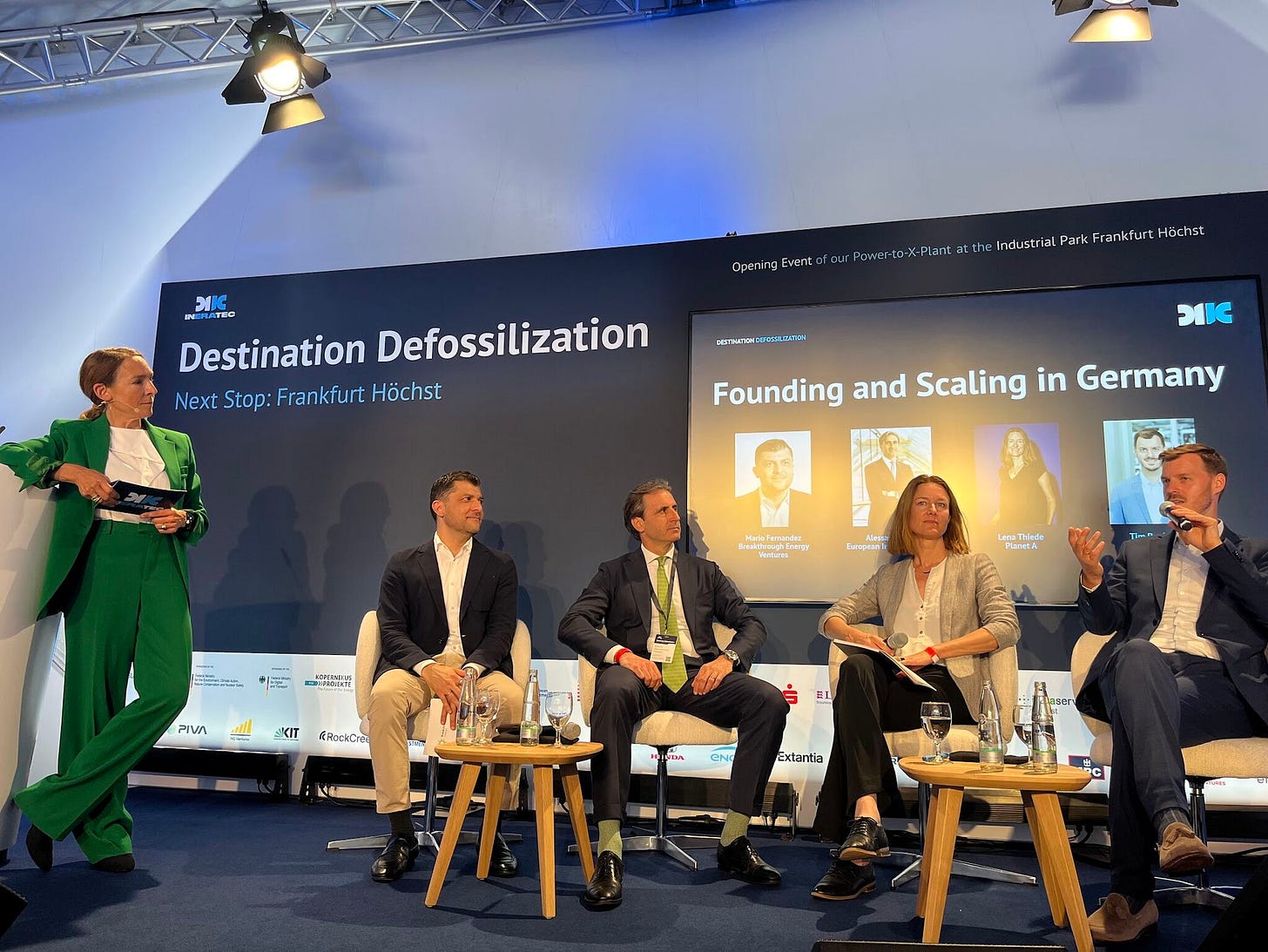What INERATEC's Frankfurt e-fuel plant signals for climate tech in Europe
More than a milestone, ERA ONE is a model for how to scale clean energy solutions in a fragmented policy landscape.
This article is based on a panel discussion held during the official launch of INERATEC’s ERA ONE facility in Frankfurt-Höchst, Europe's largest operational e-fuels plant. The panel brought together leaders from Breakthrough Energy Catalyst, the European Investment Bank, and Planet A Ventures to unpack what this project signals for future climate tech in Europe.
While many climate tech startups spend years polishing pitch decks, INERATEC puts steel in the ground. In Frankfurt-Höchst, the German cleantech firm has just commissioned Europe’s largest industrial e-fuels plant.
With a capacity of 2,500 tonnes of synthetic fuels annually, ERA ONE isn’t a pilot or render; it is operational. That alone sets INERATEC apart in a sector where timelines often slip and prototypes stall.
But it’s not just the technology that makes this story worth noting. It’s the model: how INERATEC got here, what it chose to prioritise, and what other ventures, investors, and policymakers can learn.

The anti-waiting strategy
For INERATEC, the decision to build wasn’t contingent on perfect conditions. “We said we’d do it in 2021. We said it again in 2022. In 2023. In 2024. Now it’s 2025, and we’ve done it,” said INERATEC CEO Tim Böltken at the launch event.
Instead of waiting for a perfect signal, the company chose to move early. With the backing of investors including Planet A Ventures, Extantia, and Engie, alongside public funding from the European Investment Bank and Breakthrough Energy Catalyst, the team took a calculated risk: deploy capital now, build fast, and prove it can be done.
“That decision to not wait was everything,” said Mario Fernandez of Breakthrough Energy. “Most people wait. Tim and his investors decided to build. That was a courageous decision.”
Modularity as a strategy
ERA ONE was never intended as a one-off. From the outset, INERATEC designed the plant using a modular approach—combining standardised, replicable units with site-specific infrastructure.
“This is the blueprint,” said Fernandez. “INERATEC can plug-and-play across Europe’s industrial hubs. That’s how you scale climate tech.”
By co-locating the plant next to a biogenic CO2 source and a hydrogen byproduct stream, the company reduced transport costs and energy input requirements. The result: a proof point for both technical viability and commercial relevance.
The capital curve
The funding package has been significant. Most recently, it involved a €70 million plant financing commitment, comprising €40 million in European Investment Bank (EIB) venture debt and €30 million from the Breakthrough Energy Catalyst. But capital came with questions.
“At the beginning, you sell the dream,” said Böltken. “But once you raise serious money, scrutiny rises. Investors start asking: What’s your conversion rate? Efficiency? Capital deployment?”
This mirrors a brutal truth from our book, Sustainability in the Air: the vast majority of climate tech startups die before Series A. The survivors, however, use investor pressure to sharpen focus, not slow down.
Scaling with substance
Building an industrial-scale plant in two years defied expectations. But speed wasn’t recklessness. “You don’t just need the tech,” Böltken said. “You need the team, the structure, the systems. That takes maturity.”
Speaking as part of the panel, Lena Thiede of Planet A Ventures captured this tension well: “Impact without scale is meaningless. But scaling without sustainability can be reckless.” INERATEC’s success shows that speed and rigour aren’t mutually exclusive but co-dependent. Only those who prepare internally can survive external demand.
The role of policy
What’s holding Europe back isn’t a lack of money. Instead, there is an issue around regulatory fragmentation.
“The funding is there,” noted EIB’s Alessandro Izzo. “But it’s split across 27 countries, agencies, and regulators. That kills momentum.”
INERATEC succeeded because it worked around that. The Frankfurt site offered a unique alignment of biogenic CO2 supply, hydrogen availability, and supportive policy frameworks. It was about building fast and about building smart.
As Thiede pointed out during the panel, European institutions are finally aligning decarbonisation with security and competitiveness. But to deliver results, bold projects like ERA ONE need fewer bureaucratic hurdles and more policy clarity.
Perseverance as a competitive advantage
In climate tech, most startups fail not from bad ideas, but from exhaustion of cash, time, or leadership will.
The broader lesson, shared by all panellists, was one of perseverance. “That’s the key,” said Böltken. “We just kept saying we’d do it. And we did.”
That echoes the most consistent theme from our book research: execution beats vision every time. INERATEC didn’t wait for better timing or safer terms. It built. And by building, it shifted the narrative: synthetic fuels aren’t just plausible, they’re happening.
The lesson for other companies in this sector is clear: stop chasing theoretical milestones, build something real, find aligned capital, and accept that perseverance will be your greatest differentiator.
Because the future doesn’t belong to those with the best slides.
It belongs to those who put steel in the ground.


